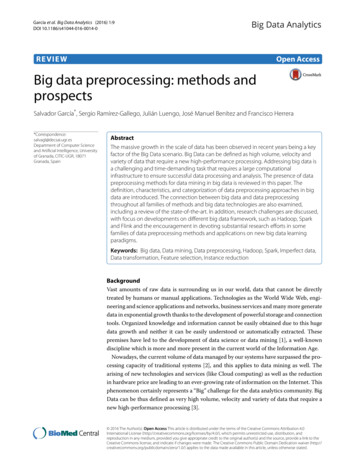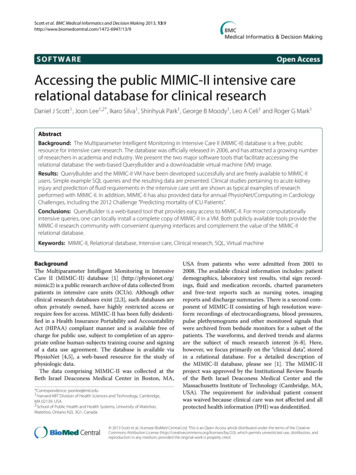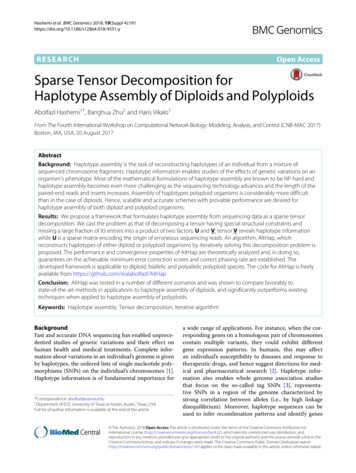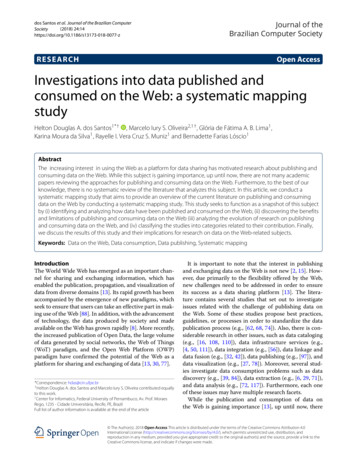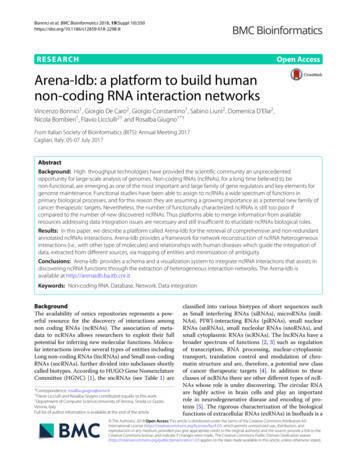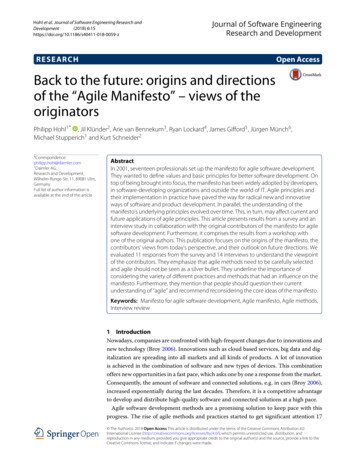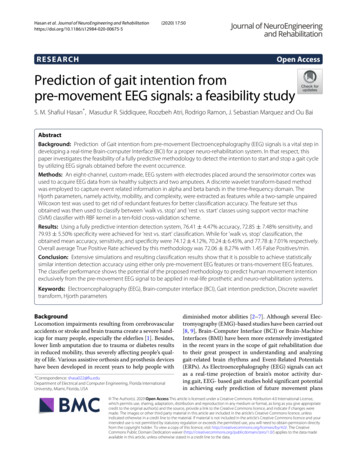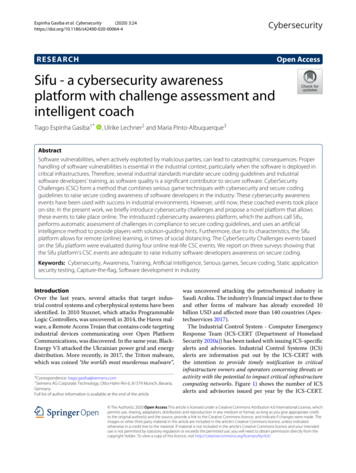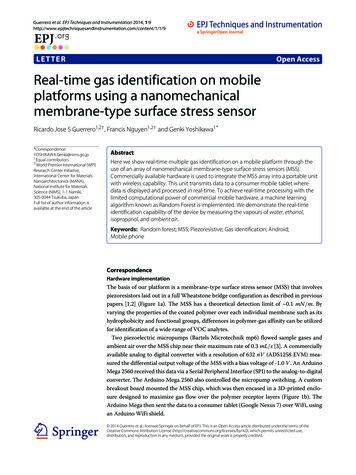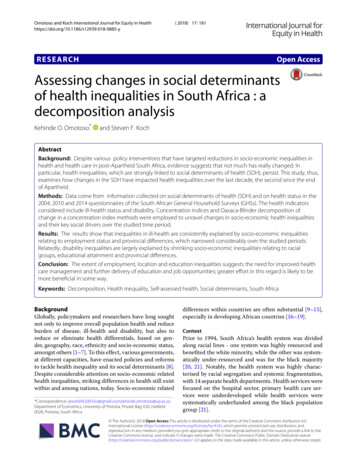
Transcription
Omotoso and Koch International Journal for Equity in 18) 17:181R ES EA R CHOpen AccessAssessing changes in social determinantsof health inequalities in South Africa : adecomposition analysisKehinde O. Omotoso*and Steven F. KochAbstractBackground: Despite various policy interventions that have targeted reductions in socio-economic inequalities inhealth and health care in post-Apartheid South Africa, evidence suggests that not much has really changed. Inparticular, health inequalities, which are strongly linked to social determinants of health (SDH), persist. This study, thus,examines how changes in the SDH have impacted health inequalities over the last decade, the second since the endof Apartheid.Methods: Data come from information collected on social determinants of health (SDH) and on health status in the2004, 2010 and 2014 questionnaires of the South African General Household Surveys (GHSs). The health indicatorsconsidered include ill-health status and disability. Concentration indices and Oaxaca-Blinder decomposition ofchange in a concentration index methods were employed to unravel changes in socio-economic health inequalitiesand their key social drivers over the studied time period.Results: The results show that inequalities in ill-health are consistently explained by socio-economic inequalitiesrelating to employment status and provincial differences, which narrowed considerably over the studied periods.Relatedly, disability inequalities are largely explained by shrinking socio-economic inequalities relating to racialgroups, educational attainment and provincial differences.Conclusion: The extent of employment, location and education inequalities suggests the need for improved healthcare management and further delivery of education and job opportunities; greater effort in this regard is likely to bemore beneficial in some way.Keywords: Decomposition, Health inequality, Self-assessed health, Social determinants, South AfricaBackgroundGlobally, policymakers and researchers have long soughtnot only to improve overall population health and reduceburden of disease, ill-health and disability, but also toreduce or eliminate health differentials, based on gender, geography, race, ethnicity and socio-economic status,amongst others [1–7]. To this effect, various governments,at different capacities, have enacted policies and reformsto tackle health inequality and its social determinants [8].Despite considerable attention on socio-economic relatedhealth inequalities, striking differences in health still existwithin and among nations, today. Socio-economic related*Correspondence: zaDepartment of Economics, University of Pretoria, Private Bag X20, Hatfield0028, Pretoria, South Africadifferences within countries are often substantial [9–15],especially in developing African countries [16–19].ContextPrior to 1994, South Africa’s health system was dividedalong racial lines - one system was highly resourced andbenefited the white minority, while the other was systematically under-resourced and was for the black majority[20, 21]. Notably, the health system was highly characterised by racial segregation and systemic fragmentation,with 14 separate health departments. Health services werefocused on the hospital sector, primary health care services were underdeveloped while health services weresystematically underfunded among the black populationgroup [21]. The Author(s). 2018 Open Access This article is distributed under the terms of the Creative Commons Attribution 4.0International License (http://creativecommons.org/licenses/by/4.0/), which permits unrestricted use, distribution, andreproduction in any medium, provided you give appropriate credit to the original author(s) and the source, provide a link to theCreative Commons license, and indicate if changes were made. The Creative Commons Public Domain Dedication o/1.0/) applies to the data made available in this article, unless otherwise stated.
Omotoso and Koch International Journal for Equity in HealthPost 1994, the South African health system has developed into a two-tiered system which is unified and moreco-ordinated. The National health plan, developed by theAfrican National Congress (ANC) in 1994, charted a newpath for a codified and a more coherent health system [22].Primary health care (PHC) was made the cornerstone ofhealth policy, with the introduction of free medical treatment for pregnant women and children younger than 6years in 1994 and 1996, and subsequent extension to allusers. The 14 fragmented health departments were alsoconsolidated into one national and nine provincial healthdepartments. Driven by the need to redress inequities anddiscriminations, the health system is being transformed,through different documented reforms, polices and programmes (including the on-going implementation of thenational health insurance (NHI) scheme) [21, 23–31], intoan integrated and comprehensive health care system.The health care system, which provides services foran estimated population of over 58 million people, comprises the private and public sectors. Basically, SouthAfrica’s public health care system contains five layers,namely: primary health care (clinics), district hospitals,regional hospitals, tertiary/academic hospitals and central/academic hospitals. This structure was developed toaddress cost effective health care for all citizens, on anappropriate level, and to ensure better health for all. Themajority of the population access health services throughgovernment-run and funded public clinics and hospitals. The public health services are divided into primary,secondary and tertiary through health facilities that arelocated in, and managed by, the provincial departments ofhealth [32].South Africa is committed to the health of her citizensand equitable access to better health care services [33].This right to health is deeply rooted in post-apartheidSouth Africa’s constitution, which specifies that ‘everyonehas the right to have access to health care services, including reproductive health care’ [34]. Thus, everyone hasaccess to both the public and private health services. However, access to private health services depends largely onan individual’s ability to pay: individuals can either chooseto pay out-of-pocket or purchase private insurance inorder to be treated at private hospitals and health clinics.Public health care provides mostly free services and careto all citizens, including pharmaceuticals, wheelchairs andcrutches, and home care visits, amongst others. However,public health care is often characterised by problems, suchas long waiting times, rushed appointments, old facilities, poor disease control and prevention practices, andpoor quality of care, when compared to private healthcare [32, 35].In post-apartheid South Africa, improving health outcomes is prioritised in health and cognate policies andreforms. At the core of these policies and reforms is(2018) 17:181Page 2 of 13the continuous fight against the quadruple burden ofdisease, namely HIV/AIDS and TB, maternal, infantand child mortality, non-communicable/chronic diseases,ill-health/injury and violence that plague the country[36, 37]. Although enormous effort has gone into addressing each of this burden of disease, it remains a challengeto the public health system [29]. This burden of disease isclosely associated with the vast socio-economic inequalities that characterise the country, known as one of themost unequal in the world [38–40], even as the government fights against social injustice and socio-economicinequalities in all facets of life. Thus, addressing socialdeterminants of health has been a cornerstone in primaryhealth care (PHC), its re-engineering strategy [41], and theNational Development Plan (NDP).Policy contextSince the emergence of democracy in the last twodecades in South Africa, considerable effort has goneinto redressing the damaging impacts of Apartheid,which was characterised by legislated inequality. Specifically, the South African government has embarkedon a variety of policies and reforms to reverse the discriminatory practices that pervaded all aspects of lifebefore 1994 [42]. Policy interventions have targetedreductions in socio-economic inequalities in variouscapacities, and, by extension, these policies have alsoapplied to the health care system: fiscal redistributiontargeted at health, education, social protection sectors;abolition of user fees at the primary health care (PHC)level in 1994; extension of PHC policy to all users inrelatively poorer households in 1996; introduction ofGovernment Employees MedicalAid Scheme (GEMS) in2006 and ongoing discussions related to universal healthcare coverage through yet-to-be-fully-implementednational health insurance (NHI) [23–25, 28, 43, 44].However, evidence suggests that not much has reallychanged [32, 45–47]. In particular, health inequalities, which are strongly linked to social determinantsof health (SDH), persist [48–50]. To further addresssocio-economic related health inequalities, a broaderunderstanding of the changes that have occurred over thepost-apartheid period might be insightful.Problem statementIn the literature, health inequality and its socialdeterminants have received considerable attention[18, 21, 23, 33, 35, 48, 50–58]. Some of the preceding studies find poor self-reported health to be higheramong lower socio-economic groups [50, 51, 55]. Onestudy finds that the burdens of major categories of selfreported illness and disability are greater among lowersocio-economic groups [50]. In a related study, socialprotection and employment, knowledge and education,
Omotoso and Koch International Journal for Equity in Healthhousing and infrastructure contribute to disparities ingood self assessed health (SAH) [48]. Moreover, thereis strong indirect racial aspect to health inequalities inSouth Africa [57].However, the existing empirical analysis of healthinequality is, to a large extent, cross-sectional. It focusesat a given point in time and might apply one-way decomposition to examine the contributions of socio-economicfactors to health inequality. Moreover, they tend to focuson only a few health indicators. With few indicators, wemay only see narrow view of health inequalities and, thus,may underestimate overall health inequality. Single-timeassessment of health inequality, on the other hand, maydownplay the effects of health inequality-focused reforms,as it does not uncover dynamics that are vital for indirect assessment of the effectiveness, or otherwise, of priorpolicies and health interventions aimed at reducing socioeconomic related health inequalities. For instance, onerecent study with cross-sectional one-way decomposition explains the social factors that account for healthdisparities [48]. It is relevant for understanding healthinequalities in South Africa, but only provides information about health inequality at a given point in time. Itcannot uncover changes in health inequalities. Yet, it isimportant to understand those changes and the extent towhich they have been impacted by, for example, changesin social factors, especially in a country such as SouthAfrica, which has worked and is still working to redresssocio-economic related health inequalities by targetingkey social factors. Doing so can help to identify key driversof changes in health inequality and, thus, improve theefficiency of resource allocations to further reduce healthinequalities. Moreover, areas that need further improvement or interventions can be highlighted. It can also serveas feedback during the policy review process, especiallywhen considering reforms directed at socio-economic factors that are often targeted by policy.To consider these dynamic aspects, we make use ofexisting methodological developments in the literatureto extend previous analyses [48, 50], which we discussbelow. The data used in our analysis was sourced from the2004, 2010 and 2014 General Household Surveys (GHSs).The initial year, 2004 marks the recommendation for theimplementation of National Health Insurance in SouthAfrica [44] and coincides with the 10 year anniversary ofthe end of Apartheid; 2014 marks an additional decadedown the line, while 2010 indicates the enactment of keypolicies, programmes and service priorities to reduce theburden of premature death and improve equity, efficiencyand quality of health care in the South African health system [43]. Therefore, the analysis allows us to correlatehealth policies from the second decade post-apartheid,indirectly, with either a widening or narrowing of healthinequality.(2018) 17:181Page 3 of 13Our empirical strategy adopts the concentration indexregression model and Oaxaca-type decomposition ofchange in the concentration index [59, 60]. The concentration index method was employed to uncover the relativechange in health inequalities over the studied periods,linking those changes to changes in the SDH. The decomposition of change in the concentration index explainshow changes in health inequalities are attributable tochanges in social determinants. We apply the method toill-health status and disability.MethodsData sourceData used in this study was sourced from three waves ofSouth African General Household Surveys (GHSs); onefrom 2004 [61], another from 2010 [62] and the otherfrom 2014 [63]. Although GHS data exist for 2002 and2003, the 2004 survey was chosen because 2004 marksthe beginning of the second decade of democracy, while2014 represents the end of that decade. Although a fiveyear step would be more obvious, we decide to use 2010because the survey questions were consistent with theother two surveys, which was not the case with 2009.The GHSs are repeated cross-sectional household surveyscollected annually by the national statistical agency, Statistics South Africa (StatsSA), with new samples drawn eachyear. Each year, the sample includes approximately 30,000households, following a multi-stage stratified design,such that, each sample is representative at both thenational and provincial levels within any year. The surveyscollect a range of demographic and socio-economic information on households and individuals across the country’s nine provinces. Survey questions relate to housingservices, social services, socio-demographic information,labour markets, health and health care information andhousehold tourism activities. Population weights are available in the surveys for both households and individuals.To account for the different survey designs among thedatasets, we use the adjusted survey weights provided byStatsSA.Variables definition and measurementHealth data are based on a short series of questions covering illnesses or injuries during the past 30 days prior to thesurvey, categories of disease/illness, dysfunctional disability lasting six months or more, categories of disabilities,whether an individual had access to medical aid coverage and the type of health care facility (public or private)where care would be sought in the event of illness. For aholistic outlook on health inequality, information relatedto health status in the two surveys were considered in ouranalysis.Health status is measured by ill-health and disability. Inthe surveys, ill-health status is based on whether or not the
Omotoso and Koch International Journal for Equity in Healthrespondent suffered from any illness or injury during thepast month. Each respondent was asked whether he/sheis limited in his/her daily activities, at home, at work or atschool, because of a long-term physical, sensory, hearing,intellectual, or psychological condition, lasting six monthsor more. Positive responses are defined as disabled. Eventhough the GHS has some limitations, in that it doesnot contain explicit information on SAH and quality ofhealth care, we use the information on ill-health/injury,which has been identified to be an important predictor of morbidity or mortality, especially in developingcountries [64, 65].Social determinants of health included in our analysis are based on WHO identified domains that influencepro-equity progress towards universal health care. Someof the domains include income and poverty, knowledgeand education, housing and infrastructure, social protection, gender norms, and other individual/householdfactors [48]. Information collected in the GHS that isin line with the WHO identified domains on SDH,consistent in all surveys, and thus, used in our analysis includes: employment status; social grant recipient status; highest level of education completed (noschooling, less than diploma, diploma/certificate, university degree, and postgraduate degree); province andurban/rural setting; age; gender; race (black Africans,coloured, Asian/Indian and white), marital status (married, widow/widower, divorced/separated and single), andsocial grants/assistance receipt status.Socio-economic variables such as education, socialgrants and employment were not just included in theanalysis on the basis of WHO identified domains or dataavailability, but were included to capture the realities ofchanges in the socio-economic outlook of the country.For instance, since the emergence of democracy in SouthAfrica, policy redressing all forms of socio-economicrelated inequalities were enacted, creating a more equitable national system. These policies improved access toeducation, social grants, employment, housing and healthcare, especially for the previously disadvantaged (nonwhite) groups. Over the post-apartheid period, there hasbeen a relative increase in receipt of formal education andsocial grants by black Africans. In particular, the noncontributory old age pension and child grant have a strongracial dimension, with a considerable proportion of blackAfricans and coloureds as beneficiaries [66, 67].Moreover, the GHS includes information on the ownership of household assets and services. We use thatinformation to construct a wealth index, which servesas a proxy for our measure of socio-economic status;in the absence of data on household income. Following[68] 1 , a wealth index was constructed in each of the survey years using the method of factor analysis (FA) 2 ona set of seven variables measuring relative wealth; source(2018) 17:181Page 4 of 13of drinking water, presence of electricity, land line/cellularphone, television set, radio, refrigerator and car. Thus, wewere limited to wealth-related questions that were available in all surveys. Furthermore, this is our measure ofsocio-economic status.Empirical methods of estimating health inequalityEstimating a concentration indexAs suggested earlier, we use the concentration index (CI)and decomposition of change in the concentration indexfor the analysis. The concentration index is employedbecause it presents an accurate picture of socio-economicinequalities in health, and has been used in a number ofrelated studies [69–75].For our empirical estimation, the standard concentration index is defined as twice the covariance between ourhealth variable (H), e.g ill-health, and the ranking of socioeconomic status (S) divided by the mean of the healthvariable, μ [69, 70, 76]:CI 2cov(H, S).μ(1)It can also be written as : n2 Hi Si 1.CI nμ(2)i 1where μ is the mean of Hi ; Si is the fractional rank ofthe ith individual in the socio-economic groupings; CI isthe concentration index which is the measure of relativeinequality, such that doubling the health variable leaves CIunchanged. CI takes a value of zero when a health variabletakes the same value among all individuals irrespective oftheir socio-economic status; CI is negative when a healthvariable is more concentrated among the poor than thebetter-off, and vice versa.For ease of computation and generation of standarderrors, from which statistical inferences can be made, theCI is specified as a regression: 2 Hi2σs α βSi βj Xji υi .(3)μjis the variance of the fractional rank; α is thewhereintercept; β is an estimate of the CI; βj are the parametervectors of the determinants Xj ; and υi is the error term.σs2Decomposing a change in concentration indexThe concentration index of a health variable can bedecomposed into the contributions of individual factorsto its inequality, where each contribution is the product ofthe sensitivity of the health variable with respect to thatfactor and the degree of inequality in that factor [60].Our decomposition analysis relies on modeling the linear relationship between a health variable of interest, H,and the contributions of the j determinants, Xj :
(2018) 17:181Omotoso and Koch International Journal for Equity in HealthH α jβj Xj υ.(4)where βj are the parameters’ coefficients of Xj , and υ is theerror term. By substituting (4) into (2), the overall concentration index (CI) can be rewritten as a linear combinationof the concentration indices of the determinants, plus anerror term, as expressed : βj X̄j υCj GCC (5)μμ .jwhere μ is the mean of health variable, H; X̄j is the meanof each j determinant; Cj is the concentration index forthe jth determinants, calculated from (2) by replacing thehealth variable (Hi ) with the determinant (Xj ) (definedanalogously to C); GCυ is the generalised concentrationindex for the error term (υ), and C is made up of two components (5). The first is the explained component, whichis equal to a weighted sum of the concentration indicesof the j regressors, where the weight is simply the elasticX̄ity of H with respect to Xj ηj βj μj . The second is theυunexplained component, captured by the last term, GCμ ;it is the inequality in health that cannot be explained bysystematic variation across income groups in the Xj .As opposed to the cross-sectional decomposition above,it is possible to decompose health inequalities over time[60]. Specifically, one can unravel correlates of changes inhealth inequalities over time, by applying the Oaxaca-typedecomposition [59].To model the decomposition of change in the healthinequalities across time, we apply the Oaxaca decomposition of change method to (5): C ηjt Cjt Cjt 1 j Cjt 1 ηjt ηjt 1 jGCυtμt .(6)where t refers to time period and denotes first differences. In (6), we weight the difference in concentrationindices by the second period elasticity and weight the difference in elasticities by the first period concentrationindex. An alternative to (6) would be to weight the difference in concentration indices by the first period elasticityand weight the difference in elasticities by the secondperiod concentration index as expressed in (7): C jηjt 1 Cjt Cjt 1 j Cj ηjt ηjt 1 GCυtμt .(7)As indicated earlier, this decomposition allows one todecompose the change in SES-related inequality in ahealth variable into changes in inequalities in its determinants, on one hand, and changes in the elasticities ofthe health variable with respect to these determinants,Page 5 of 13on the other hand. Our empirical estimation follows thisapproach in explaining changes in SES-related inequalitiesin health over time. Estimates were based on linear probability models (LPMs), which are appropriately weightedto the population and robust to heteroskedasticity. LPMswere employed due to the binary nature of the dependenthealth variables of interest.One key assumption underlying the method is that theremust be a consistent measure of socio-economic status,and population must be observed at least in two differentpoints in time. In our analysis, the measure of socioeconomic status is the wealth index, while we apply themethod using three different time periods; 2004, 2010 and2014. Data were analysed using Stata 14 [77].ResultsData summaryTable 1 presents the data summaries by survey year. Theresults are presented in terms of the relative proportionsof observations across the survey years. Compared withthe 2004 and 2010 surveys, the 2014 survey containedfewer individuals aged less than 30 years, females andwhite. However, it contained more black Africans. The2004 survey comprised more individuals below 30 yearsof age, females, coloured, white and single, while moremarried individuals are contained in the 2010 survey.Notably, the 2014 survey had more educated individualswith diplomas or certificates and an honours degree, butfewer people having no formal education. In comparisonwith 2004 and 2010, 2014 data is less rural, with fewerindividuals living in the Eastern Cape, Northern Cape,Free State, Kwazulu-Natal and Limpopo, while more individuals are living in the relatively richer provinces ofWestern Cape and Gauteng. Moreover, social grant beneficiaries have greater coverage, while unemployment ratesare lower in 2004 than in 2014. The results further suggest that the surveys contained similar proportions ofIndians, as well as those who live in the Northwest andMpumalanga provinces in 2004, 2010 and 2014.Compared with 2004 and 2010, health status in 2014 isbetter, as a lower share of individuals reported ill-health.On the contrary, there is a sharp increase in disabilityreports in 2010. Similarly, medical aid coverage rates areproportionately higher in 2010, than in 2004 and 2014.However, fewer individuals prefer to utilise public healthcare when ill in 2010, while proportionally more individuals would prefer private health care in 2014, than inprevious studied periods.Health concentration indices for 2004, 2010 and 2014Table 2 presents the health concentration indices for2004, 2010 and 2014 (estimates are from (3)). The resultsshow the relative changes in health inequalities over thedifferent time periods. Ill-health is more concentrated
(2018) 17:181Omotoso and Koch International Journal for Equity in HealthTable 1 Summary statistics (mean) of the dependent andindependent variables, GHS 2004, 2010 and 2014Variable2004201020140 - 5 yrs0.1300.1250.1186 - 17 yrs0.2570.2380.22718 - 30 yrs0.2490.2440.24231 - 45 yrs0.1940.2050.21546 - 64 yrs0.1270.1390.14665 yrs 0.0430.0480.053Female0.5170.5140.512Black .2780.276Single0.7280.7200.722No schooling0.1950.1670.149Less than 50.041Honours ployed0.3080.2860.306Urban0.5630.6140.638Western Cape0.1070.1110.114Eastern Cape0.1350.1280.124Northern Cape0.0230.0220.022Free anga0.0780.0780.078Limpopo0.1060.1050.104Grant e 6 of 13in 2004 and 2010, while it is more concentrated among thebetter-off in 2014, although the results are not statisticallysignificant in 2004 and 2010.Ill-health concentration indices for 2004 and 2010 were0.018 and -0.017, respectively, indicating a concentrationof ill-health amongst the poor over time, and an increasein inequality between 2004 and 2010. Similarly, disabilityconcentration indices for 2004 and 2010 were -0.000 and-0.004, respectively, suggesting that disability was moreconcentrated among the poor in each, and a worsening in inequality between the time period. Between 2004and 2010, changes in ill-health and disability concentration indices were -0.035 and -0.004, respectively. Thesechanges are pro-poor and widened over that time period.On the contrary, the concentration indices for ill-healthand disability changed by 0.026 and 0.037 over the period2010 and 2014, suggesting that they become more concentrated among the better-off. In what follows (see Table 3),we present the results of the social determinants thatcontribute to the observed changes in the health concentration indices. Each row in Table 3 was estimated basedon the calculations from (6). In presenting the results,we emphasise variables whose socio-economic inequalities have consistently reduced health inequalities over theperiods.The results further suggest that, in all the surveyyears, ill-health is less concentrated among the relativelyyounger individuals, when compared with those agedabove 65 years. Similarly, those living in the WesternCape and KwaZulu-Natal provinces report illness lessoften. Furthermore, those who are relatively educated andemployed are less likely to report disability, while theopposite was observed for females and those without formal education. We find disability to be less concentratedamong those who are educated and employed in 2004,2010 and 2014. Disability is also found to be less concentrated among residents of relatively urban provinces.However, single individuals, those without formal education and social grant recipients are more likely to sufferfrom disability; such a result is expected, since one of thesocial grants is a disability grant.Disability0.0260.0800.031Medical aid coverage0.1560.1800.179Public health facility0.7510.7300.734Decomposition resultPrivate health facility0.2480.2530.262MeanMean97,03695,764In Table 3, we present the Oaxaca decomposition resultsfor the health indicators, separately, for 2004–2010 and2010–2014, respectively. These results show the extentto which inequalities in the health indicators are due tochanges in socio-economic inequalities in their associated social determinants. While interpreting these results,one needs to bear in mind that our proxy for socioeconomic status is wealth, and ill-health and disabilityinequalities relatively worsened (became more pro-poor)over the period 2004–2010, while the inequalities narrowed (became more pro-rich) between 2010–2014. EachObservations92, 445Estimates are weighted to the population using the sample weightsamong the poor in 2010, but more concentrated amongthe better-off in 2004 and 2014; however, the result isnot significant at conventional levels in 2014. Similarly,disability is somewhat more concentrated among t
factors [48]. Information collected in the GHS that is in line with the WHO identified domains on SDH, consistent in all surveys, and thus, used in our anal-ysis includes: employment status; social grant recipi-ent status; highest level of education completed (no schooling, less than diploma, diploma/certificate, uni-
